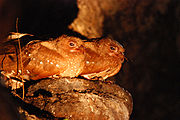
Cueva del Guácharo National Park
Encyclopedia
The Guácharo Cave National Park (Spanish
: Parque Nacional Cueva del Guácharo) is located 12 km from the town of Caripe
, Monagas
, Venezuela. It has as its centerpiece a large limestone cave, which is home to thousands of oilbird
s (guácharos in Spanish; scientific name Steatornis caripensis). This frugivorous, nocturnal species was made known to science by Alexander von Humboldt
and named by him after the town of Caripe.

Oilbirds are fruit-eating birds that live within the first section of the cave; they leave at night in search of food. The Spanish name guácharo is onomatopoeic, and comes from an old Castilian word for one who shrieks or cries, because of their characteristic sound. They are brown with black and white spots, have a long tail and bristles around their beak. They measure around 48 cm in length, including the tail. The guácharos produce an organic layer in the cave called guano
, formed by excrement and vomited seeds, which provide the basic nutrients for the cave's ecosystem. The most important daily event in the park occurs in the evening, as dusk falls, when the birds exit the cave in great flocks, in search of food.
Spanish language
Spanish , also known as Castilian , is a Romance language in the Ibero-Romance group that evolved from several languages and dialects in central-northern Iberia around the 9th century and gradually spread with the expansion of the Kingdom of Castile into central and southern Iberia during the...
: Parque Nacional Cueva del Guácharo) is located 12 km from the town of Caripe
Caripe
Caripe is a town in Caripe Municipality in the mountainous north of the state of Monagas in eastern Venezuela.The soil of the Caripe Valley is very fertile, and the climate of the area is exceptionally pleasant, a result of its altitude , latitude , and proximity to the Caribbean Sea...
, Monagas
Monagas
Monagas State is one of the 23 states of Venezuela.Monagas State covers a total surface area of 28,900 km² and, in June 30, 2010, had an estimated population of 908,626....
, Venezuela. It has as its centerpiece a large limestone cave, which is home to thousands of oilbird
Oilbird
The Oilbird , also known as Guácharo, is a bird found in the northern areas of South America . They are nocturnal feeders on the fruits of the Oil Palm and tropical laurels, and are the only nocturnal fruit eating birds in the world...
s (guácharos in Spanish; scientific name Steatornis caripensis). This frugivorous, nocturnal species was made known to science by Alexander von Humboldt
Alexander von Humboldt
Friedrich Wilhelm Heinrich Alexander Freiherr von Humboldt was a German naturalist and explorer, and the younger brother of the Prussian minister, philosopher and linguist Wilhelm von Humboldt...
and named by him after the town of Caripe.
The cave
The cave itself was designated as Venezuela's first National Monument in 1949. The National Park was later created to conserve the cave and the forest eco-system where the birds feed. The cave is a limestone cavern over 10 km long, with a number of large chambers and spectacular rock formations. The temperature inside the cave generally remains near 19 °C and the humidity at 100%.Guácharo

Oilbirds are fruit-eating birds that live within the first section of the cave; they leave at night in search of food. The Spanish name guácharo is onomatopoeic, and comes from an old Castilian word for one who shrieks or cries, because of their characteristic sound. They are brown with black and white spots, have a long tail and bristles around their beak. They measure around 48 cm in length, including the tail. The guácharos produce an organic layer in the cave called guano
Guano
Guano is the excrement of seabirds, cave dwelling bats, and seals. Guano manure is an effective fertilizer due to its high levels of phosphorus and nitrogen and also its lack of odor. It was an important source of nitrates for gunpowder...
, formed by excrement and vomited seeds, which provide the basic nutrients for the cave's ecosystem. The most important daily event in the park occurs in the evening, as dusk falls, when the birds exit the cave in great flocks, in search of food.

